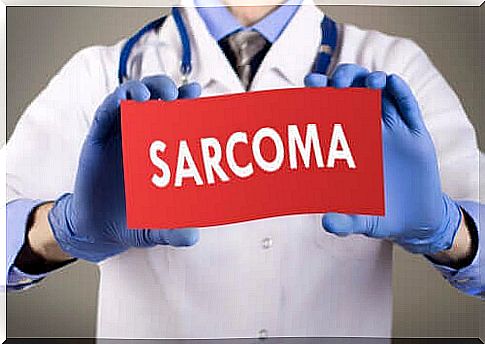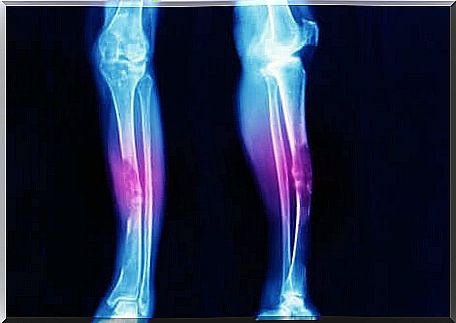Different Types Of Sarcomas And Their Characteristics

There are many types of sarcomas, and therefore it is a rather diverse pathology that can manifest itself in many different ways. It sometimes appears as lumps under the skin and there are other cases where it leads to bone pain or abdominal bloating. Weight loss can also occur.
According to the American Cancer Society (Spanish link), this disease is an oncological variant that multiplies in soft and bone tissues, from fat to nerves, muscle and bone.
Sarcomas are not common. Several studies show that osteosarcoma (a tumor in the skeleton) represents only 0.2% of all malignant cancers. This means that there is an annual incidence of about three cases per million people.
About cancer and its importance

One cannot discuss sarcomas without discussing some basic information about cancer. This disease is characterized by uncontrolled cell proliferation in certain parts of the body that causes tumors. These often spread to other parts of the body through a process known as metastasis.
The Sociedad Española de Oncología Médica (Spanish link) reports the updated data on the cancer situation at the global level:
- In 2018, more than 18 million cases of cancer were detected worldwide.
- In 11.6% of these cases there were malignant tumor processes in the lungs.
- Uterine cancer was the least frequently diagnosed (2.1%).
- However, 24.6% of cases had less common origins, which were not counted as unique variants.
- In 2019, a total of 277,234 cases of cancer were diagnosed in Spain.
There is an annual increase in the number of cases worldwide. Estimates indicate that by 2040, nearly 30 million more people will be diagnosed with a malignant tumor. This is 63% more than in 2018.
The numbers are alarming as we have read above. Therefore, it is necessary to know each of the species, no matter how rare they are, to save thousands of lives around the world.
The different types of sarcomas
As we mentioned above, all types of sarcomas are malignant tumors that grow in bones and soft tissues. According to statistics, they are responsible for 20% of solid cancers detected in children and less than 1% in adults.
The predisposition to develop this condition depends on genetic and environmental factors and on the interaction between the two factors. However, specific causes remain unclear.
According to an article published in the scientific portal ScienceDirect in 2007 (Spanish link), there are different types of sarcomas. Below we will tell you more about the different variants.
liposarcoma
This is the most common subtype and accounts for 20% of sarcoma cases in the United States. This cancer occurs throughout the body in the fat cells. In most cases, however, it occurs in the fatty tissue of the extremities or abdomen.
It is very noticeable because it usually manifests as a growing lump under the skin. It can cause pain and weakness of the affected limb as it grows into the legs and arms. In the case of abdominal tumors, the most common symptoms are constipation, bloating and abdominal pain.
In most cases, tumor removal and radiation are the best therapy. However, there are different types of liposarcoma, based on their morphology. However, these sarcomas usually do not cause metastases and only disappear after a surgical procedure.
Leiomyosarcoma
According to the organization sarcomahelp.org (Spanish link), a leiomyosarcoma is derived from smooth muscle cells – usually from the uterus or stomach tissue. This type comprises 5 to 10%, making it one of the most common types of sarcomas.
There are no specific features for the diagnosis of this pathology, but the above sources report that they are more common over the age of 50 or 60 years. They also mainly affect women. Various studies show that treatment with the drug Gemcitabine works well in more than 50% of patients.
Synovial sarcoma

These sarcomas are less common and mainly occur in young adults. The tumors usually grow near the joints, especially the knees. The main feature is a slow growing, deep lump that is tender or painful to the touch.
Research shows that this type of cancer is correlated with certain chromosomal variations. This means that it has a large genetic component. As with liposarcoma, surgical removal is the best option.
Other types of sarcomas
We have covered three of the main types above. However, there are a number of other types of sarcomas that we should not forget. We list a number of types:
- Angiosarcoma, which occurs in the cells of the blood vessels or the lymphatic vessels.
- Kaposi’s sarcoma produces pink nodules under the skin or, less commonly, on the oral mucosa. It often manifests in people with weakened immune systems, such as those with AIDS.
- Rhabdomyosarcoma is a malignant tumor of the skeletal muscle. In fact, this is the most common type of childhood sarcoma. It has an incidence of four affected children per million healthy children.
- Osteosarcoma, as the name implies, is bone cancer.
As you have read, there are as many types of sarcomas as human tissues and the list is extensive. The most important concept to keep in mind is that we are dealing with a malignant tumor with different variations depending on the location.
What should we remember about sarcomas?
Sarcomas are cancers that develop in both soft tissues and bone tissue. Therefore, there are multiple types that manifest with specific symptoms depending on where the tumor grows.
As with any other cancer, early detection is key to a patient’s survival. Therefore, if you notice a suspicious lump or have unexplained pain, consult your doctor immediately.









